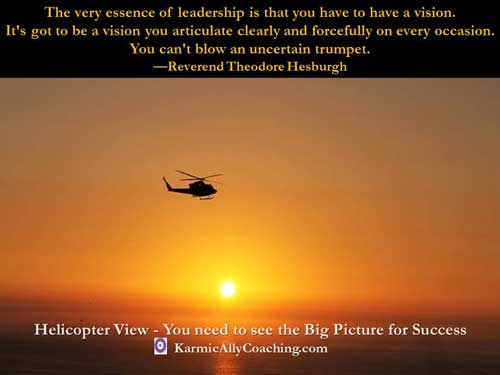This post has already been read 7746 times!

Ever had your boss talk about seeing or focusing on the Big Picture when you know you need to focus on completing work deadlines?
He’s sharing his Helicopter View with you.
Quite possibly, the more he elaborates on his plan, the feeling of overwhelm and stress starts creeping in.
I mean, how are you supposed to think about his vision when you’re under pressure to deliver results in the short-term?
When you know you will have your performance judged on the basis of agreed deliverable and you’re in operations, not strategy?
That was exactly what my colleagues and I thought when we were pulled off our National Offsite Training Program because the Managing Partner had an important message to deliver to us.
It must have been important, we thought.
Why else would a super busy man take the train from London to Nottingham (of Robin Hood fame) to talk to an audience of aspiring Chartered Accountants who were preparing for their final set of examinations to get the coveted initials of ACA after their name?
There we were – 100 young professionals in the Nottingham University Lecture Theater holding our breath while the big man told us what he came to tell us and what he expected from us.
It was an empty stage with a podium and the Managing Partner.
The Boss started his speech with ‘I have a dream’.
For the next 1 hour he pranced across the stage, clasping his hands, unclasping them and sharing ideas, initiatives, strategies and plans.
It sounded like Greek to us.
We listened in silence, clapped at the end of the speech and headed out in silence.
If this incident and the boss are memorable, it isn’t so much as a display of his gravitas or executive presence. It was the antics on the stage and wrong timing for his speech.
One thing was clear – there was change ahead, some jobs would be on the line. It was time to update the resume, make sure you passed your exams and get out of the firm.
I doubt that was his intention, but rumors of downsizing started circulating in our professional world.
This was after a reputed Executive Search firm found itself inundated with CVs from young semi-qualified accountants.
Managers had to jump into damage control on a war footing.

In the years following the ‘I have a dream’ speech and its unintended aftermath or aftershock, the idea of involving operations staff in an organization’s strategic thinking has evolved.
Earlier companies had a top-down approach where the Vision and Mission Statements were created at the top of the company pyramid and then trickled down the ranks for operations.
The new approach is to have professionals contribute to the organization’s strategic thinking.
Some companies have perfected the art of employee participation. Others are on the road to incorporating it enabling their staff to contribute towards creating the big picture.
This approach has merit. It ties the high level conceptual thinking with information gleaned from practical grass root experience.
This in turn means decisions can be taken to achieve the organization’s strategic goals without running into operational roadblocks.
The savings in terms of time, effort and money are priceless for any successful business.
After all, isn’t it easier to buy-in and implement a strategy at operation level when you’ve had a say in the process of developing it?
Corporate Success Tip: Apply the Helicopter View in Operations

For the professional who has to work to achieve the short-term goals that translate into long term results, it’s an opportunity to gain more knowledge and information about how top management is thinking. It provides insights and how he or she can contribute to the ‘Big Picture’.
If you want to climb the corporate ladder and demonstrate your leadership ability, being aligned to the company vision and values is important. Otherwise, it’s time to find another job.
This means developing the skill of using the Helicopter View.
The concept of the helicopter view started with Royal Dutch Shell Company in the 20th century, when the company found it to be the common competency among its most successful executives.
The concept as it applies to leadership is simple. Imagine you are the pilot of a helicopter that is still sitting on the helipad. Your vision is limited to a small surface area below the helicopter.
But once the helicopter is off the ground, the range of vision improves in all directions and you are able to get more information about the ground and its surroundings. You even get a view of any change in weather heading your way.
In fact, the higher you go, the better the view and you can decide where you want to go based on more information of the ground and surrounding areas.
Translated back into the corporate world environment, this is a part of strategic thinking.
The mindset required is very different from operational or tactical thinking.
It requires having an overview of the external factors that can affect a business, understanding the environment in which the business is operating and what the target market needs and will buy.
It means having the ability to stand back from the daily processes and think about the long-term direction that the enterprise has to take.
Then the leader has to translate his vision into action that will help achieve the strategic goal. This could mean doing things differently or even adopting a new approach.
For a professional with an operational focus, it means being able to think both in abstract and specific terms when it comes to the task at hand.
It means being able to step back from the task, activity or issue and ask the following questions
- Ask ‘why’ questions to evaluate the activity in terms of its purpose, value and desired outcomes (Abstract thinking); and
- Ask ‘how’ questions to examine methods, processes, resource and skills requirements (Specific thinking)
Moving between both questions creates a viable solution that will improve performance and demonstrate that you possess leadership qualities.
Mastering this skill also adds to your Executive Presence.
Final Analysis of ‘I have a dream’
There was a major failure in communication.
The Boss gave us what should have been an inspiring speech but ended up confusing the audience. That’s because we hadn’t been trained to look at the firm’s big picture.
We were told about his abstract thinking but were not provided with the specifics to achieve the dream.
We didn’t have the required Helicopter View to even understand what he was saying. As a result, we didn’t buy in or know how to support the dream he had.
Once you learn this skill, you can apply it in all areas of your life. It takes time but it’s worth the effort.
How will you apply the Helicopter View to your work?
Click the image below to get your Executive Presence Checklist and become memorable for all the right reasons.






 I adhere to the Certified Coaches Alliance Code of Ethics and Standards. A copy is available on request.
I adhere to the Certified Coaches Alliance Code of Ethics and Standards. A copy is available on request.
 Let's Talk through the Connect Form:
Let's Talk through the Connect Form:
Thanks, Vatsala! What do you do if you don’t get the information you need from your superiors in order to get the helicopter view?
It depends, Vanita. Some companies have a policy of giving operations staff information on a ‘need to know’ basis while others are more engaging.
If you need the additional information to carry out your tasks at the operations level, the best way is to ask your immediate supervisor or reporting head for the information so you can complete the first part of the exercise. Requests quoted in the right language and form often get us the information we need to improve our efficiency and productivity.
Great post Vatsala!!
Thanks Sunil. I knew you’d like this post. 🙂
When I was in the corporate world, it was pretty much the trickle down process. We weren’t invited to contribute ideas or solutions and many of us were very unhappy watching things go from bad to worst. And, of course, it was our fault the corporate agenda didn’t manifest the way it should. Nice to hear that businesses have expanded their view and inclusion.
I think a lot of it has to do with the new style of leaders who know the value of getting the implementation staff involved early on to mitigate costly errors, Joyce. The corporate world is indeed changing!
Vatsala I really enjoyed this post because I am a Gestalt thinker who is always looking for the big picture so I can work backward to the beginning. As you so wisely pointed out using the idea of writing a novel, you must be able to take your audience with you or they will get lost in the translation, as this one did. Great Blog!
Thanks Kathleen. Both the why and how are important if we want to achieve great results. 🙂
Fascinating topic! I’ve always been a BIG picture person and often made my bosses crazy asking questions. Of course, I had a taste of being on the receiving end of that when I began managing teams myself.
Reading the comments I was especially interested in Sue’s point about how her tai chi teacher told her to focus on “how” because I tend to do that myself when I’m facing a major obstacle and challenge myself with “Okay, HOW can I make this happen.” I enjoy learning how different people approach things like this. Thanks for the inspiration Vatsala!
We do come a full circle when we become managers, don’t we Marquita. 🙂 I’m a how person too but find it useful to figure out my why part because it keeps me motivated and the end goal stays in mind. I’m glad you enjoyed the post.
My tai chi teacher always stopped my Why questions and told me to ask How instead. While I still often wonder Why something, I have learned that when I spend more time in How and less in Why I get closer to my goal. Maybe because action always appeals to me.
I can see where your Tai Chi teacher is coming from, Sue. The scope of the Why question is quite broad and one can keep thinking and theorizing til the cows come home. 🙂
On the other hand, it’s our actions based on intent that gets the job done. It’s also easier to review what we’ve done and plan our next step.
What a great “view” of how successful organizations run, Vastala! And funny enough, that’s how a great novel gets written as well. You have to approach it from the standpoint of the forest AND the trees. Fixing the minutia with a clear view of the overall at the same time.
It’s what I teach my editorial clients as well.
Just love this!
Thanks Susan. I’m always looking down memory lane to find the right story to bring home the important concept that will help career professionals in their quest to overcome roadblocks to their success. You’ve made my day!
Great post, Vatsala! Like everything, this too has two sides. I really appreciate your story of how this boss’s ‘share’ only led to confusion and demoralization. So interesting. Everything needs to ‘land.’ This man wasn’t talking to you, he was talking past you or over you. You extracted a great lesson there in how to both receive and deliver a helicopter view. This is a great reminder for me as I share the vision of AtoZ Healing Space! Thank you!
Thanks, Reba. The entire audience lost the plot that time. 🙂 You are on the mark that delivering and receiving a helicopter view requires more than just giving it. I KNOW you’ll keep on track while sharing the vision of AtoZ Healing Space. To your Success!